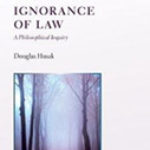Globalisation, Criminal Law and Criminal Justice: Theoretical, Comparative and Transnational Perspectives

Editors: Valsamis Mitsilegas, Peter Alldridge, and Leonidis Cheliotis
Publisher: Oxford, UK; Portland, OR: Hart Publishing, 2015. 243p.
Reviewer: Andrew Novak | September 2015
Globalisation, Criminal Law and Criminal Justice is a well-chosen collection of critical criminology selections spanning the topics of law enforcement, transnational crime, comparative and European law, and “crimmigration” (the intersection of immigration and criminal law) among others. All of the contributions challenge the prevailing status quo in popular and academic opinion, and several do this very well. The book is of primary relevance to scholars, though the critical nature and easy readability of some of the chapters make them appropriate for classroom study (to this end, I assigned Peter Andreas’s excellent chapter to my undergraduate class this semester).
In Chapter 1, Roger Cotterrell persuasively recasts the distinction between mala in se crimes (wrong by nature, like murder and robbery) and mala prohibita crimes (wrong simply because authorities prohibit them) to the sphere of international criminal law. Using sociological theory, he shows, rightly I believe, that international criminal law will develop into the mala prohibita sphere as the international community solidifies and becomes more integrated.
David Nelken’s chapter on social indicators raises fascinating questions about the limitations of criminological statistics in light of social realities. Incarceration rates, for instance, tell us little when they fail to account for length of sentences. In addition, many social indicators align with the economic and political interests of those collecting the data, often located in the Global North. Nelken’s explanation for how globalization changes the use of statistics (for instance, attached to donor aid to the Global South) is essential for any discussion about social indicators.
The chapter by Peter Andreas questions the media- and scholar-driven narrative that the informal economy and the spread of transnational crime are subverting the global political system and reaching unprecedented scale. Rather, he argues that statistics on illicit economic flows are deeply suspect and often compiled and used by groups that have an interest in exaggerating the true figures. Looking to history, such as alcohol smuggling during Prohibition or evasion of tariffs, he shows how once-profitable illicit trade was obliterated overnight simply by changes in government regulation. This is a powerful reminder that the distinction between licit and illicit is only dictated by the state and the state’s political reality: the international system treats the drug trade, for instance, which benefits the Global South at the expense of the Global North, very differently from the arms trade, which benefits the Global North in arms sales at the expense of the Global South. Andreas’s contribution is a reminder that much of the global underground economy is, in part, of governments’ own making.
Andreas’s chapter is matched by Robert Reiner’s expert chapter on policing and economic divisions in a society. He ponders the recent and incomplete development of law enforcement as a subject of academic inquiry, compared to the highly developed field of law. He notes that lawyers are often drawn from middle or higher classes, while law enforcement often comes from working classes and primarily casts its power on lower classes. Policing is dirty work, he writes, and therefore historically marginalized in criminal justice study. Reiner’s research establishes a link between policing and political economy and provides a powerful critique of the “neoliberal” model of policing that is now dominant in Western societies.
In Chapter 5, Margaret Beare determines that institutional law enforcement reactions to public accusations of misconduct and reactions to internal whistleblower and discrimination complaints. Does the force react with openness or with denial? She also complicates the distinction between high (security) and low (municipal) policing by looking at how the Royal Canadian Mounted Police justifies low police misconduct by referencing high police motives and tactics. This thesis is valuable because it recognizes that police responses to accusations of misconduct, whether internal or external, reveal the health of the force.
The chapter by Leonidas Cheliotis is on informal migration to Europe, using Greece as a case study. He highlights a conundrum: the Greek state criminalizes illicit migration and uses conditions of detention that violate prevailing human rights norms, yet Greece subtly encourages such conditions as migrants are often willing to work in exploitive labor conditions in order to avoid the inhumane conditions of detention. Unfortunately, as Cheliotis rightly concludes, Greece profits from its detention crisis, making the status quo extremely resistant to change. The chapter is engaging and important, if sobering.
John Spencer engages another irony of European integration in Chapter 7, describing how the United Kingdom resists a European prosecutor and Europe-wide application of criminal law, but probably has the most to gain and the least to lose from European criminal legal integration. He convincingly explains how the UK’s common law due process protections, vastly improved since the 1980s, set a relatively good example for the rest of the continent, especially as to pretrial detention. This chapter is more hopeful than the one by Cheliotis: the UK may well come to recognize its true interests.
Chapter 8, by Valsamis Mitsilegas, is probably the most difficult chapter in the book. He traces the development of European law with respect to transnational organized crime and corruption and shows how the European Union and Community are now major players in transnational crime control, previously the domain of individual states. The chapter is the longest in the book and requires a familiarity with the European legal order. Nonetheless, the implication of the chapter is that Europe is becoming integrated not only in the substance of criminal law, but in the continent’s relations with the global legal regime.
The chapter by Christopher Harding as to the changing relationship between global criminal and administrative law is another paradigm-challenging contribution. He compares differences among European states about where to draw the line between criminal conduct and punishments on the one hand and administrative violations and penalties on the other, using competition/antitrust law as a case study. He describes the potential for European and international administrative law to expand into the criminal realm, by finding international criminal liability for persons engaged in anti-competitive conduct. The growth of international administrative law is of increasing interest to criminologists, and Harding’s chapter is an important starting point.
Following Harding’s lead, the chapter by Michael O’Kane explores another aspect of the linkage between global administrative law and criminal law. Using the example of anti-cartel enforcement, O’Kane persuasively details how enforcement and prosecution tactics are becoming harmonized to engage with an increasingly transnational threat. In particular, he describes the success in the UK and the European Union of the American approach of allowing selective leniency for perpetrators who take the initiative in admitting anti-competitive conduct and cooperate with an investigation. However, he acknowledges that the global trend toward more severe criminal sanctions for cartel activity may discourage perpetrators from seeking leniency for fear of prosecution in other nations where their conduct has transnational effects. The result may be further global integration as to anti-cartel enforcement.
As a whole, the book is remarkably even for an edited volume. All of the contributions engage existing literature and identify new points of departure for research at the frontiers of international criminology and criminal law. The book is a worthwhile contribution to any academic library or criminal justice collection.
Andrew Novak is Adjunct Professor of Criminology, Law, and Society at George Mason University and the author of The Death Penalty in Africa: Foundations and Future Prospects (Palgrave 2014)


